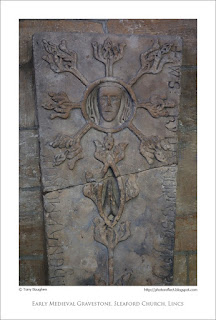The gravestones, tomb slabs and funerary monuments of English churches range in date from the twelfth century to the present day. Each one seeks to remember or exalt the deceased. Few of the older ones are in the position where they were first placed and many of these have been damaged by incident, accident or design. Sometimes they have been crudely cut so that a later architectural embellishment could be effected. Often Protestant zealots of the Reformation or later have taken their hammers to them, knocking off noses, limbs and any other easily removed projection as they sought to demonstrate their hatred of "idolatry". However, despite the vicissitudes of time, many have survived, largely intact, bequeathing to later generations information about the sculptural abilities and stylistic preferences of earlier times.
The oldest such monuments were often lids for stone coffins, decorated by a foliate cross or lines of stylised leaves. These usually date from the 1100s. Also found at this time, and a little later, are stone coffin lids with circles, quatrefoils or almond-shaped holes within which are carvings of parts of the body that is being commemorated. Today's photographs show an example of just such a gravestone that can be seen in the church of St Denys at Sleaford, Lincolnshire. The viewer is invited to look, asit were, through "holes" in the surface of the lid, at the face, hands held in prayer and feet of a woman. The inscription around the edge tells us who she is. It says, "Ye who here pass by, for the soul of Yvette pray, who was the honoured wife of William of Rauceby on whose soul may god have mercy". These holes are incorporated in a leafy cross that decorates the surface of the coffin-shaped stone. It is likely to date from the 1100s. Despite being broken in two and now being fixed to the wall rather than laying flat on or under the ground, the stonework is still clear and the writing remains legible, a testament to the durable qualities that the sculptor conferred on the piece and to the care with which the church has been maintained for the past thousand or so years.
photograph and text © Tony Boughen
Camera: Sony RX100
Mode: iAuto+
Focal Length: 10.4mm (28mm - 35mm equiv.)
F No: f1.8
Shutter Speed: 1/30
ISO: 400
Exposure Compensation: 0 EV
Image Stabilisation: On

